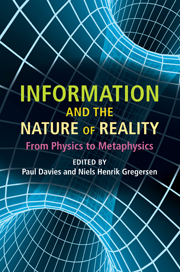Book contents
- Frontmatter
- Contents
- About the authors
- Acknowledgments
- 1 Introduction: does information matter?
- Part I History
- Part II Physics
- Part III Biology
- 7 The concept of information in biology
- 8 What is missing from theories of information?
- 9 Information and communication in living matter
- 10 Semiotic freedom: an emerging force
- 11 Care on Earth: generating informed concern
- Part IV Philosophy and Theology
- Index
- References
10 - Semiotic freedom: an emerging force
from Part III - Biology
Published online by Cambridge University Press: 06 December 2010
- Frontmatter
- Contents
- About the authors
- Acknowledgments
- 1 Introduction: does information matter?
- Part I History
- Part II Physics
- Part III Biology
- 7 The concept of information in biology
- 8 What is missing from theories of information?
- 9 Information and communication in living matter
- 10 Semiotic freedom: an emerging force
- 11 Care on Earth: generating informed concern
- Part IV Philosophy and Theology
- Index
- References
Summary
The term “information” has become nearly omnipresent in modern biology (and medicine). One would probably not exaggerate if the famous saying of evolutionary biologist Theodosius Dobhzhansky, that “nothing in biology makes sense except in the light of evolution” should nowadays be reframed as “nothing in biology makes sense except in the light of information.” But are those two concepts, evolution and information, somehow internally related? And if so, how?
INFORMATION IN EVOLUTION
In textbooks, newspapers, and even scientific papers, the meanings of the terms “evolution” and “information” are generally supposed to be well known, and they are rarely explained. And yet, there is no general consensus in science, or even in biology, about what they really mean. For instance, the preferred exemplar (in the Kuhnian sense) of evolution by natural selection is that of industrial melanism. In woodlands, where industrial pollution has killed the lichens and exposed the dark brown tree trunks, dark forms of the peppered moth – melanics – are supposedly better camouflaged against predation from birds than are the light gray forms that predominated before the Industrial Revolution. The observation by 1950 that darker forms had largely displaced lighter forms was thus taken as evidence for natural selection in action. This exemplar does indeed illustrate the effect of natural selection, but whether it shows evolution depends on your idea of evolution.
- Type
- Chapter
- Information
- Information and the Nature of RealityFrom Physics to Metaphysics, pp. 185 - 204Publisher: Cambridge University PressPrint publication year: 2010
References
- 34
- Cited by

